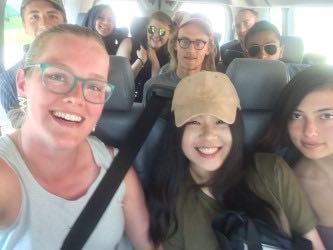Changemaker Catalyst Award recipient Carolyn Isaacson spent a week in Detroit with other designers, planners, and artists at Design Futures, an annual student leadership forum for architects and designers. Isaacson completed her Master of Architecture in May at Tulane University. She is currently an architectural designer at Landon Bone Baker Architects, a community based design firm in Chicago.
By the end of day one at Design Futures in Detroit I knew I was just starting to build a network of curious intellectuals determined to make good design for all. It was thrilling to be surrounded by like-minded individuals looking for innovations in socially-good design and yearning to make change through policy for more just and equitably designed cities. Over the course of the next week I met professionals who shared inspirations as well as trials of their work in public interest design. I listened to stories of Detroit locals working in their own communities and making change as organizers and leaders, corner store owners and artists, librarians and developers.

Design Futures is an annual student leadership forum focused around social equity. In its sixth year, Design Futures 2018 took place in Detroit, Michigan at the University of Detroit Mercy over the course of a week in May. This conference gathers students and faculty, design practitioners and community advocates in a different city every year to share new and old experiences with social justice and changemaking in design. Each day, we chose from a selection of workshops covering a wide range of topics including indigenous ideology in visual communication design, how to facilitate design and communicate with others, and methods of dismantling oppression in design.
When I applied, I hoped to meet other students and practitioners who are becoming urban changemakers and actively utilizing their theoretical understanding of public interest design for tangible shifts in their community. I hoped to share ideas about how to dismantle rent intensification in my home city of Chicago. I hoped to meet other students and practitioners who listen to the community they serve as a designer or planner and make informed design decisions with the individuals of that community.

Through Design Futures my understanding of public interest design has deepened. I can explain in three parts; first, in the realm of race where design and planning can expose, break down, and highlight invisible boundaries in urban settings. Secondly, public interest design exists in the realm of equity and engagement where all city dwellers are embraced for their use and existence in the built environment/urban space. Public interest design also collects a transdisciplinary swathe of professionals, advocates, and activists who are leaders of important conversations as well as activators of social change.
The best thing I can report from my experience at Design Futures is that I met people like I hoped. The goal of Design Futures conferences is building network. After all the workshops were done we closed the week with a series of debrief conversations and silent reflection. I joined my fellow students to create various action plans that reflected each of our goals for what to do next with the knowledge and insights gained over the course of the week.
My work in public interest design is just beginning. I am inspired by urban changemakers and aspire to join that class of designers, artists, and advocates as I re-enter the architecture profession. Design Futures was a transformative experience for me to learn more about current public interest design work and discourse. I am eager to work alongside the long list of community members who fill up the town halls, who are your neighbor standing behind you in the grocery line, and who cast ballots at the polls – this legion of supporters is critical to making public interest design work. Design Futures taught me that individuals matter, community matters and power can be used positively to create spaces that are equitable and just.
